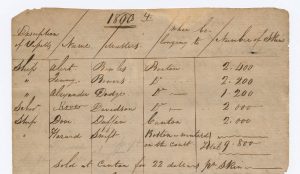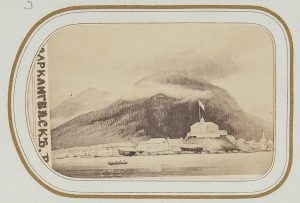by Alexandra Bush, Digital Production Assistant
Autobiographical reminiscences of the sea otter trade, a short composition comprised of just 22 handwritten pages, contains an account by William Sturgis of the Northwest sea otter fur trade between Boston and Canton, China. Although brief and outwardly unremarkable, something about this account compelled me, who digitized it, and my colleague, who catalogued it, to stall our work and read it in its entirety. Written by a young man at the beginning of a long career in overseas trade, Sturgis’ account offers a cursory glimpse into the still small but burgeoning American fur industry at the beginning of the 19th century; the stakeholders who shaped it, the greed that fueled it, and the trauma left in its wake.
At sixteen years old, William F. Sturgis (1782-1863) embarked on his first voyage from Boston on the ship Eliza, bound for the Pacific Northwest. Following news of his father’s death abroad, the eldest Sturgis son was thrust into financial responsibility, seizing a position as a low-level mate on a trading ship belonging to his employers, Thomas and James Perkins. The aim of the Eliza and six concurrent voyages like it was to trade cloth, arms, powder, coats, and dye to the indigenous peoples of the coastal Northwest in exchange for sea otter skins. These seven ships made up most of the United States’ stake in the Northwestern fur trade, which subsisted on commercial bases in Boston and Canton. Sturgis, by all accounts a pragmatic and studious young man, soon became an asset to his ship and was rapidly promoted. By 1804 he was the captain of his own vessel, and by 1806 he was admiral of a small fleet and had abandoned the Northwest fur trade altogether in favor of the China Trade.
Sturgis’ account includes very little of the above context, most of which comes from a memoir written years later by Charles Loring. In his description of the Eliza’s 1799 voyage, Sturgis provides a list of every American ship present in the area during that season’s trade, her captain, and the total number of furs she accumulated by the end of the year. He also provides a grand total of furs gathered and the average price at which they sold, along with a list of the most popular goods up for barter. In 1799, for example, a total of 11,000 furs were gathered by the seven ships, which sold in Canton for an average of $25 apiece. That year, the traders bartered blue and red broadcloth, muskets, gunpowder, greatcoats, dye, and coarse cutlery in exchange for the furs. Every year’s account starts the same, and it is easy to gauge the steady growth of the fur trade overtime given these numbers. By 1802, the total number of furs gathered grew to 14,000, but they sold for only $20 apiece.

Each year begins with a neat list of figures like that summarized above. From there, the reports become much less organized. Seemingly at a loss for where to begin, Sturgis often makes generalizations about the state of the trade in a given year. All four years of Sturgis’ tenure in the Northwest sea otter trade can best be summarized by his statement from 1801:
“The erroneous idea which was cherish’d respecting the immense profits made in the Northwest Trade induce’d many venturers to engage in it without either information or Capital – the consequence was that any one acquainted with the business might foresee, that almost all of them made losing voyages.”
Sturgis goes on to relate a story, the gist of which he repeats at least once per year and at times once per season. At the eve of 1801, multiple ships outfitted with only enough provisions for a single season’s trade descended upon the same small group of ports in quick succession, all competing for skins. The resulting competition drove up the barter price to an alarming level, such that “a spectator would have thought [the traders’] sole object was to get rid of their Cargoes as soon as possible without minding what they got in return.” The price was so high that other traders were laughed out of port for trying to offer less than 10 fathoms of cloth or three muskets for a singular skin. Before that season, the going rate was 3 fathoms per skin or 1 musket for 2 skins. For ships outfitted for longer trading voyages, 1801 turned out to be an unprosperous year of scrounging for remaining stores of skins and sailing far afield to unload cargo at a profitable rate. This seemed an incurable scenario doomed to repeat every year. At best, prices stabilized by the following season and the trade continued. At worst, ships loaded with skins were lost at sea at the hands of inexperienced captains (1800, 1802), crews starved after trading their food stores for last-ditch profits (1800), and cordial trade deals turned violent when price negotiations soured (1801).
This last point, the violence, is another topic to which Sturgis cannot seem to stop himself from returning. While he himself occasionally uses racist language to describe indigenous Northwesterners in his account, in general Sturgis was widely known for his deep appreciation of Native American culture. Enamored with the interpersonal aspects of commerce with these groups, he worked overtime to familiarize himself with the languages and customs of each, attempting to establish a friendly rapport. Sturgis’ peers did not share his passion. He describes multiple instances of violence against native people in the forms of trade coercion and overblown revenge. In one instance, the ship Bell Savage was attacked by a certain tribe while docked on an island in modern-day Alaska. The captain of another ship, Charlotte, returned later to retaliate and inadvertently murdered members of a completely different tribe. Much later, yet another trading ship docked at the same island only to be attacked again by members of the second tribe, who were understandably confused and enraged by the previous attack.
However, the longest and most harrowing story in Sturgis’ composition involves the Russians, who held several large pockets of land in Alaska at this time, along with the Tlingit people of the Sitka Sound. In his account, Sturgis summarizes the short history of the Russian presence in that area; Russian fur traders settled there around 1799, and while initial interactions with the Tlingit were friendly, the latter soon began to resent the colonists’ presence. According to the Russians, Tlingit living in or around the fort were technically under the purview of the Czar, which meant Russians were free to marry Tlingit women and force Tlingit men into free labor. Fights broke out within the year and continued sporadically until 1802.
Around that time, one of the trading ships from Sturgis’ group, the Jenny, was given assistance and shelter by the people of a particular Tlingit village on Sitka Sound. The villagers told the Jenny’s crew of their plight, and asked for help in forcing the Russians to allow their people more rights. Not only did the crew of the Jenny refuse, but they and another American vessel made the eventual decision to act in defense of Russia’s interests in the hopes of establishing a future commercial advantage. They sailed back to the village that had aided the Jenny, met with the chiefs under the guise of friendly trade, and captured or murdered several people in a surprise attack. Aboard the ship, one Tlingit hostage was singled out for execution, at which point he made a furious speech about the treachery of the Americans. Why would they side with the Russians, he asked, and why specifically attack the group that recently helped American sailors? Sturgis was apparently present, and the speech disturbed him. He attempts to quote it in its entirety within his account before describing the “peculiarly disturbing” manner in which the Tlingit man was subsequently executed.
After Sturgis is finished describing this incident, he repeats news he heard from a fellow trader that the Russians took revenge on the Tlingit people of Sitka Sound soon after, a conflict known now as the Battle of Sitka. The Tlingit were forced to leave the area in secret, afraid the Russians would enslave them, after the fourth day of battle. In what they saw as an act of mercy, they murdered the elderly people and children of their tribe to prevent them from slowing the escape and falling into the Russians’ clutches. The commander who gave Sturgis the news was one of the first to return to the base after it was deserted, only to find it littered with bodies. After relating this story, Sturgis writes one last halfhearted paragraph about another lost ship before concluding his account altogether.

This account is unique in its brevity and carries with it an oddly disembodied sense of empathy. The shame that Sturgis undeniably felt as he recounted his experiences is extremely palpable. So too is the air of helplessness apparent in his descriptions of the actions of others involved in his industry. His efforts at equitable trade and friendliness were clearly not enough to set a precedent or change the racist views of his peers. His continued compliance in the trade despite his misgivings speaks to his reluctance to jeopardize his position, but he cannot help himself from returning to the worst events in his account. It is easy to understand why he abandoned the fur trade after only a few years, despite the financial success and notoriety it brought him.
Later in his career, Sturgis publicly redoubled his advocacy by denouncing the continued expansion of the United States and Britain, arguing that the lands they claimed rightfully belonged to the indigenous people already living there. The last few pages of his account, written in another hand but seemingly dictated by him, describe the eventual decline of the Northwest sea otter trade due to scarcity of live otters after 1829.
The MHS holds a digital-only copy of this manuscript. Images of the manuscript in full can be found on our website.
For further reading

